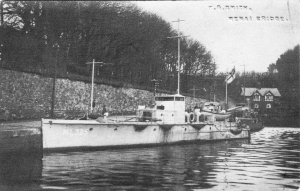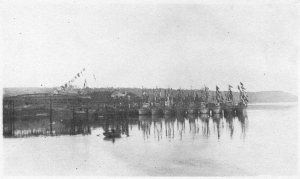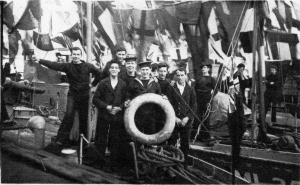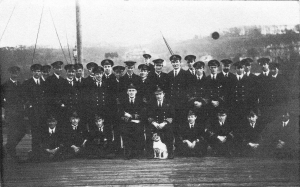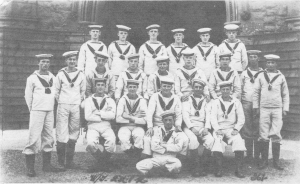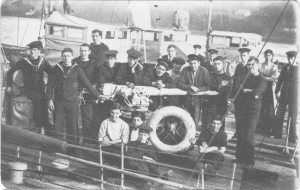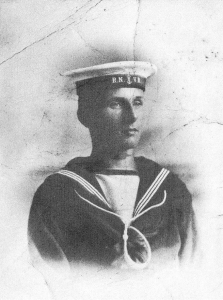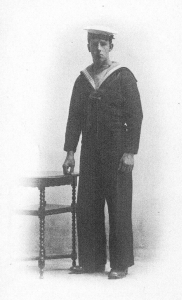The Motor Launch Patrol in the Western Approaches and Irish Sea, 1917-1919
Mr Jones was born in March 1899. Upon leaving the College School in Chester, he joined the Cheshire Lines Railway at the now-defunct Northgate Station as a railway telegraphist. Shortly after his seventeenth birthday he enlisted in the Royal Naval Volunteer Reserve in April 1917 for three years or the duration of the war.
He trained as a Wireless-Telegraphist at HMS Victory VI W/T School, a Naval shore station located in the grounds of the Crystal Palace at Sydenham in south London. After completing training he was initially posted to the Dover Patrol (HMS Attentive III - Dover & The Downs - Patrol Area XI) as of October 20th 1917 on duty as Ordinary Telegraphist in the armed trawler Seaward Ho.
On January 17th 1918 He was transferred to Queenstown (HMS Coleen - Patrol Area XXI) where he was deployed to the Motor Launch Patrol operating from that station.
Mr Jones was born in March 1899. Upon leaving the College School in Chester, he joined the Cheshire Lines Railway at the now-defunct Northgate Station as a railway telegraphist. Shortly after his seventeenth birthday he enlisted in the Royal Naval Volunteer Reserve in April 1917 for three years or the duration of the war.
He trained as a Wireless-Telegraphist at HMS Victory VI W/T School, a Naval shore station located in the grounds of the Crystal Palace at Sydenham in south London. After completing training he was initially posted to the Dover Patrol (HMS Attentive III - Dover & The Downs - Patrol Area XI) as of October 20th 1917 on duty as Ordinary Telegraphist in the armed trawler Seaward Ho.
On January 17th 1918 He was transferred to Queenstown (HMS Coleen - Patrol Area XXI) where he was deployed to the Motor Launch Patrol operating from that station.
The Admiralty commissioned no less than 580 motor launches (ML's) to patrol the coast of the British Isles during the latter part of the 1914–18 War. Some also operated in the Mediterranean, West Indies and the White Sea. They were intended to replace the earlier MB class vessels and their duties included scouting, anti-submarine work, inshore minesweeping, smokescreen-laying and hydrophone monitoring.
The concept of an armed motor launch anti-submarine patrol was first proposed in February 1915 by the American Henry R Sutphen of the Electric Boat Company, (Elco), at a meeting with an Admiralty representative in New York. Sutphen proposed a "mosquito fleet" of 19-knot 80-footers each armed with a quick-firing gun. In subsequent communications these craft were referred to by the code-word "Sutphens"!
The first fifty ML's were ordered in April 1915. These vessels were 75ft x 12ft x 4ft and were laid down at the Elco yard in Bayonne, New Jersey. The scale of the job meant complete standardisation of construction. In order not to compromise the neutrality of the United States Government it was arranged that the components be overlanded by rail to the Davie shipyard at Quebec and therefore the boat carcasses had also to comply with the intervening railroad loading guages.
The concept of an armed motor launch anti-submarine patrol was first proposed in February 1915 by the American Henry R Sutphen of the Electric Boat Company, (Elco), at a meeting with an Admiralty representative in New York. Sutphen proposed a "mosquito fleet" of 19-knot 80-footers each armed with a quick-firing gun. In subsequent communications these craft were referred to by the code-word "Sutphens"!
The first fifty ML's were ordered in April 1915. These vessels were 75ft x 12ft x 4ft and were laid down at the Elco yard in Bayonne, New Jersey. The scale of the job meant complete standardisation of construction. In order not to compromise the neutrality of the United States Government it was arranged that the components be overlanded by rail to the Davie shipyard at Quebec and therefore the boat carcasses had also to comply with the intervening railroad loading guages.
While this supposedly substantial order was being progressed news came in of the torpedoing of the Lusitania. This atrocity largely precipitated a following order for no less than 500 ML's for delivery by mid-November 1916 and the Elco yard had to tool-up for a prodigious feat of mass-production hitherto unknown in the shipbuilding industry!
The Quebec assembly yard was enlarged and a further assembly facility was leased at Montreal. Elco were contracted to make all deliveries at the launching slips in the St Lawrence river and from that point the ML's were loaded aboard ocean transports for the trans-Atlantic passage. Usually four boats were loaded aboard each ocean transport. During the winter of 1915–16, when the St Lawrence was iced-up, no less than eighty–four M.L.'s were overlanded by rail to Halifax, Nova Scotia, an ice-free port, in order to be shipped across the Atlantic.
Principal personnel engaged in the production of ML's were the Elco chief designer Mr Irwin Chase, the Bayonne plant general manager Mr Thomas S Hanson, purchasing engineer Mr EB Conrad, chief boat constructor Mr Charles Lamont and Mr Eugene A Riotte of the Standard Motor Construction Company with whose engines the whole of the ML's were fitted. At the Canadian assembly operation, material assistance was rendered by Mr PL Miller, general manager of Canadian Vickers Ltd., Montreal and Mr George Davie, general manager of the Davie Shipbuilding and Repairing Co. Ltd., of Quebec.
The Quebec assembly yard was enlarged and a further assembly facility was leased at Montreal. Elco were contracted to make all deliveries at the launching slips in the St Lawrence river and from that point the ML's were loaded aboard ocean transports for the trans-Atlantic passage. Usually four boats were loaded aboard each ocean transport. During the winter of 1915–16, when the St Lawrence was iced-up, no less than eighty–four M.L.'s were overlanded by rail to Halifax, Nova Scotia, an ice-free port, in order to be shipped across the Atlantic.
Principal personnel engaged in the production of ML's were the Elco chief designer Mr Irwin Chase, the Bayonne plant general manager Mr Thomas S Hanson, purchasing engineer Mr EB Conrad, chief boat constructor Mr Charles Lamont and Mr Eugene A Riotte of the Standard Motor Construction Company with whose engines the whole of the ML's were fitted. At the Canadian assembly operation, material assistance was rendered by Mr PL Miller, general manager of Canadian Vickers Ltd., Montreal and Mr George Davie, general manager of the Davie Shipbuilding and Repairing Co. Ltd., of Quebec.
Some exercises in adaptability became necessary; for instance the Tiffany Studios, whose production was hitherto restricted to ornamental and artistic metalwork, addressed themselves very successfully to the production of bronze castings for rudders and quadrants! The 550 ML's were eventually got out in 488 days, a rate of 1.13 vessels per day!
A final 30 ML's were ordered during July 1917 and the last of these was delivered by February 1918. All the vessels were numbered consecutively from 1 to 580 as they were produced.
The Davie shipyard at Quebec, which was leased for assembly, is still in operation as of July 1985. In 1952 Elco became a division of the General Dynamics Corporation and the Elco Navy Yard at Bayonne eventually ceased operation and is now the site of what is known as the Elco Marina.
The particulars of ML's 51 to 580 was as follows: 37 tons displacement, 46 tons gross, 80 x 12-1/4 x 4 ft. Twin-screw, petrol engines 2 x 6 cylinders, 440 bhp, 19 knots. In mid-1916 the fuel specification was modified for safety reasons to a mixture of one part petrol to two parts paraffin. Crew of 8. Armament consisted of one 3-pdr Hotchkiss gun and six depth charges. Ammunition was stowed forward and the depth charges were stowed aft.
A final 30 ML's were ordered during July 1917 and the last of these was delivered by February 1918. All the vessels were numbered consecutively from 1 to 580 as they were produced.
The Davie shipyard at Quebec, which was leased for assembly, is still in operation as of July 1985. In 1952 Elco became a division of the General Dynamics Corporation and the Elco Navy Yard at Bayonne eventually ceased operation and is now the site of what is known as the Elco Marina.
The particulars of ML's 51 to 580 was as follows: 37 tons displacement, 46 tons gross, 80 x 12-1/4 x 4 ft. Twin-screw, petrol engines 2 x 6 cylinders, 440 bhp, 19 knots. In mid-1916 the fuel specification was modified for safety reasons to a mixture of one part petrol to two parts paraffin. Crew of 8. Armament consisted of one 3-pdr Hotchkiss gun and six depth charges. Ammunition was stowed forward and the depth charges were stowed aft.
At least 82 ML patrol units were formed (Units 500-581) each consisting of six vessels. In the Auxiliary Patrol the boats were manned by RNVR personnel including many who had served in the earlier MB's. Nineteen ML's were lost while on active service, most of these losses occurring in the coastal waters of the British Isles. Another five were lost while being transported on ocean vessels that were attacked and sunk. The ML's featured with distinction in the attack on Zeebrugge on April 23rd 1918.
The Auxiliary Patrol around the British Isles was organised into designated areas. Area XXII was based on Holyhead and the parent ship was Amethyst III. This patrol area comprised the eastern Irish Sea including Cardigan Bay. The Area's western limit was a meridian drawn from the Mull of Galloway, touching on the Calf of Man and Bardsey Island and intersecting the Cardigan coast in the region of Newport Bay. The eastern limit was a line drawn from the southern tip of Walney Island to the Great Orme's Head. Inshore of this line was patrolled by the Liverpool local patrol. These were the limits as defined by mid-1915 to the 1919 de-mobilisation.
In April 1918, eight ML's (181, 187, 320, 325, 410, 487, 132 & 167) completed fitting out as a Hunting Flotilla at Queenstown and were detached to Holyhead under the immediate orders of Lieutenant-Commader CV Norcock, RN. This officer had been brought off the Retired List for the duration. Two ML's were fitted out with Wireless Telegraphy, ML 325 and ML 187. Lieutenant-Commander Norcock directed operations from ML 325. The other ML's in the flotilla were kept in communication by flag and morse-lamp signals. The radio call sign assigned to ML 325 was H J W.
The commander of ML 325 at this time was Lieutenant Bidwell, RNVR and Sub-Lieutenant Harold I Vince, RNVR, a Canadian, was second-in-command.
Their counterparts in ML 187 were Sub-Lieutenant Colin C Duncan, RNVR, and Sub-Lieutenatn Leslie Woodman, RNVR, and Mr Jones' counterpart in wireless telegraphy was Archie Evans from South Wales.
During the time Mr Jones was a crew member ML 325 was involved in late 1918, together with her consorts, in two U-boat actions; one with gunfire and the other with depth charges. Although detached to Holyhead, the Hunting Flotilla was not restricted to the Holyhead patrol area and was free to operate up to the Irish coast and frequently put into the Irish ports for restocking etc.
Mr Jones also recalls that ML 325 ran aground off Caernarfon in 1918, damaging both her propellers, and had to be drydocked for repairs at Bangor, her crew being sent on some unexpected leave until the vessel was ready to return to service. ML 325 also experienced considerable time out of action due to trouble with the engine exhaust manifolds.
In the early months of 1919 some 200 ML's were detached from their various stations and assembled in the Hamble River on Southampton Water for final decommissioning. Here Mr Jones recalls he and his shipmates leaving ML 325 for the last time and that they had to push their seagoing kit on a handcart to Portsmouth barracks! From there they were eventually sent by train to Chatham for demobilisation and dispersal back to civilian life and, for Mr Jones, the Cheshire Lines Railway.
The average cost of each vessel, excluding armament, was 8,609 Pounds Sterling. From late 1919 the surviving boats were sold in large lots at bargain prices, i.e. 200 at 275 Pounds each, 95 at 263 Pounds each and 32 (to Malta) at 50 Pounds each! 41 boats were disposed of to the French Navy and became part of their V.1–73 series craft. By 1924 only eight boats remained in Royal Navy service and all were gone by 1927.
After 45 years service Mr Jones retired from British Rail in March 1959 and subsequently was on the staff of a travel company in Chester. He is now fully retired and lives quietly with his wife at their home in Tattenhall near chester.
Information sources: the Admiralty Public Record. The Motor Launch Patrol by Gordon S.Maxwell (Dent - 1920). British Warships of 1914-1919 by Dittmar & Colledge (Ian Allan - 1972). National Maritime Museum. Royal Naval Museum.
Compiled July 1985 by Noel F Jones. Copyright belongs solely to the auther. Reproduced here by kind permission.
The Auxiliary Patrol around the British Isles was organised into designated areas. Area XXII was based on Holyhead and the parent ship was Amethyst III. This patrol area comprised the eastern Irish Sea including Cardigan Bay. The Area's western limit was a meridian drawn from the Mull of Galloway, touching on the Calf of Man and Bardsey Island and intersecting the Cardigan coast in the region of Newport Bay. The eastern limit was a line drawn from the southern tip of Walney Island to the Great Orme's Head. Inshore of this line was patrolled by the Liverpool local patrol. These were the limits as defined by mid-1915 to the 1919 de-mobilisation.
In April 1918, eight ML's (181, 187, 320, 325, 410, 487, 132 & 167) completed fitting out as a Hunting Flotilla at Queenstown and were detached to Holyhead under the immediate orders of Lieutenant-Commader CV Norcock, RN. This officer had been brought off the Retired List for the duration. Two ML's were fitted out with Wireless Telegraphy, ML 325 and ML 187. Lieutenant-Commander Norcock directed operations from ML 325. The other ML's in the flotilla were kept in communication by flag and morse-lamp signals. The radio call sign assigned to ML 325 was H J W.
The commander of ML 325 at this time was Lieutenant Bidwell, RNVR and Sub-Lieutenant Harold I Vince, RNVR, a Canadian, was second-in-command.
Their counterparts in ML 187 were Sub-Lieutenant Colin C Duncan, RNVR, and Sub-Lieutenatn Leslie Woodman, RNVR, and Mr Jones' counterpart in wireless telegraphy was Archie Evans from South Wales.
During the time Mr Jones was a crew member ML 325 was involved in late 1918, together with her consorts, in two U-boat actions; one with gunfire and the other with depth charges. Although detached to Holyhead, the Hunting Flotilla was not restricted to the Holyhead patrol area and was free to operate up to the Irish coast and frequently put into the Irish ports for restocking etc.
Mr Jones also recalls that ML 325 ran aground off Caernarfon in 1918, damaging both her propellers, and had to be drydocked for repairs at Bangor, her crew being sent on some unexpected leave until the vessel was ready to return to service. ML 325 also experienced considerable time out of action due to trouble with the engine exhaust manifolds.
In the early months of 1919 some 200 ML's were detached from their various stations and assembled in the Hamble River on Southampton Water for final decommissioning. Here Mr Jones recalls he and his shipmates leaving ML 325 for the last time and that they had to push their seagoing kit on a handcart to Portsmouth barracks! From there they were eventually sent by train to Chatham for demobilisation and dispersal back to civilian life and, for Mr Jones, the Cheshire Lines Railway.
The average cost of each vessel, excluding armament, was 8,609 Pounds Sterling. From late 1919 the surviving boats were sold in large lots at bargain prices, i.e. 200 at 275 Pounds each, 95 at 263 Pounds each and 32 (to Malta) at 50 Pounds each! 41 boats were disposed of to the French Navy and became part of their V.1–73 series craft. By 1924 only eight boats remained in Royal Navy service and all were gone by 1927.
After 45 years service Mr Jones retired from British Rail in March 1959 and subsequently was on the staff of a travel company in Chester. He is now fully retired and lives quietly with his wife at their home in Tattenhall near chester.
Information sources: the Admiralty Public Record. The Motor Launch Patrol by Gordon S.Maxwell (Dent - 1920). British Warships of 1914-1919 by Dittmar & Colledge (Ian Allan - 1972). National Maritime Museum. Royal Naval Museum.
Compiled July 1985 by Noel F Jones. Copyright belongs solely to the auther. Reproduced here by kind permission.
